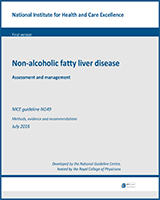From: 4, Methods

Non-Alcoholic Fatty Liver Disease: Assessment and Management.
NICE Guideline, No. 49.
National Guideline Centre (UK).
London: National Institute for Health and Care Excellence (NICE); 2016 Jul.
Copyright © National Institute for Health and Care Excellence 2016.
NCBI Bookshelf. A service of the National Library of Medicine, National Institutes of Health.